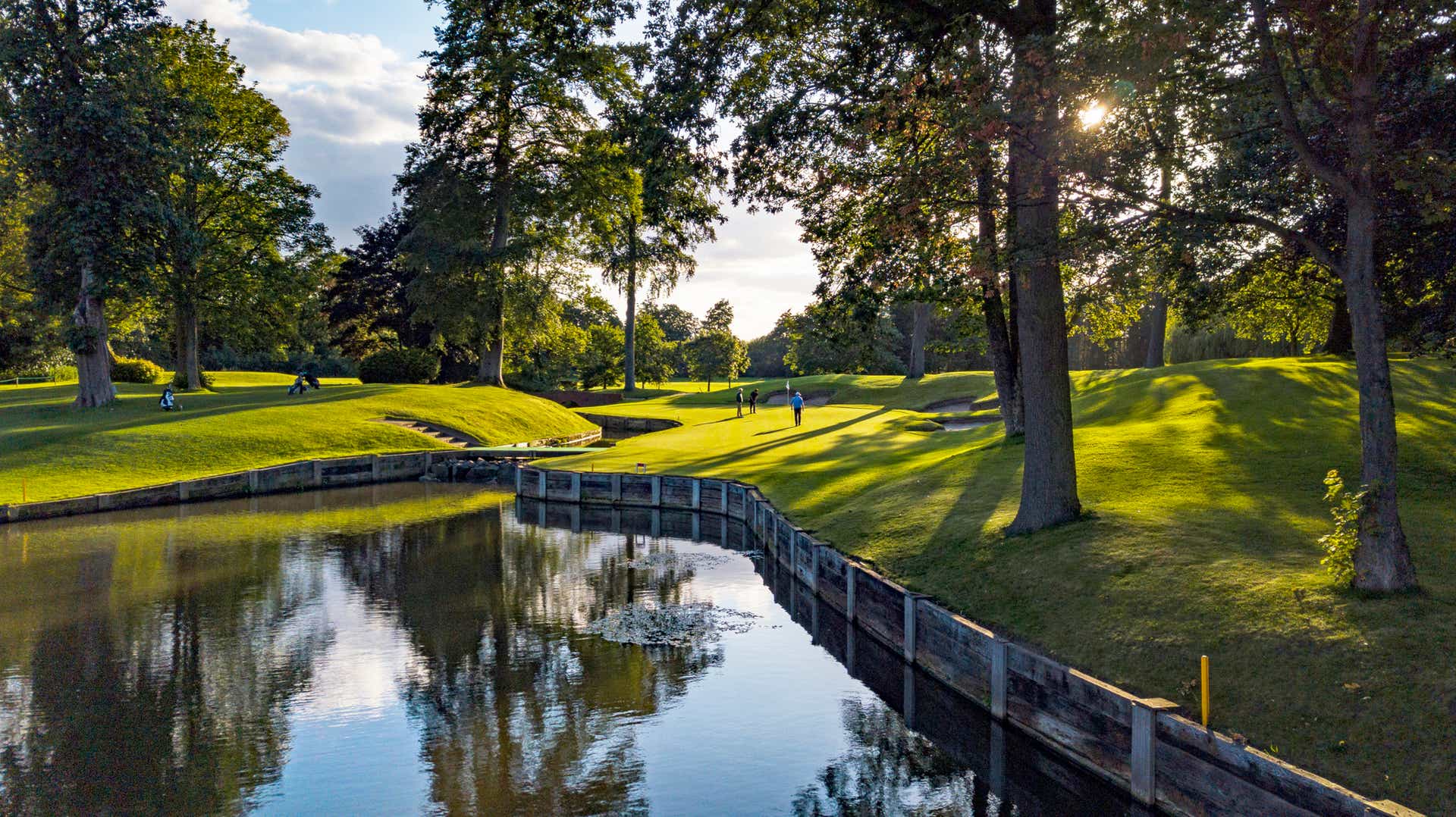Get first-hand reviews and the latest travel trends with the Golf Travel Experts.
From Jacksonville right down to Miami, it’s the sunshine state that has more than just all-year-round good weather.
With such a wide range of exceptional golf courses in Florida, we understand it can be hard to decide the best place to play. Therefore, we made things a little easier for you. Scroll down and explore what Golfbreaks has to offer for your next golf vacation, with our selection of the best golf courses in Florida.
1. The Stadium Course, TPC Sawgrass
Built by the legendary Pete Dye on what was Florida swampland. The legendary Stadium Course at TPC Sawgrass is the ultimate golfing challenge, with water, waste-bunkers, and even alligators lurking. Ensuring it remains one of the best golf courses in Florida. This magnificent layout builds and builds to an epic, water-strewn Par 5/3/4 finish that strikes fear into the hearts of Tour Pros and hackers alike, not least at the iconic island green 17th. More than 150,000 balls end up submerged there every year… will yours?
Stadium Course Facts
Length: - Back tees: 7261 yards - Front tees: 5464 yards Par: 71 Architect: Tom Weiskopf, Jay Morrish, Tom Weiskopf, and Phil Smith Founded: 1986 Course type: Stadium-style
2. King and Bear Course, World Golf Village
Home of the World Golf Village, St Augustine, some 40 miles south of Jacksonville, is a definite must-visit for anyone considering the northern areas, and fancy a stay & play at one of the best golf resorts in Florida. The Hall of Fame itself is well worth a visit, but it’s the golf we’re really interested in, particularly the King & Bear and the Slammer & Squire layouts. You’d expect courses where Nicklaus, Palmer, Snead & Sarazen collaborate to be worth a play, and these two glorious layouts will not disappoint.
King and Bear Facts
Length: - Back tees: 7279 yards - Front tees: 5119 yards Par: 72 Architect: Arnold Palmer, Jack Nicklaus, Ed Seay, MacCurrach Golf, Nicklaus, Bruce Borland, and Jim Lipe Founded: 2000 Course type: Parkland
King & Bear Course, The Renaissance Resort at World Golf Village
3. Arnold Palmer's Bay Hill Club
Arnold Palmer might have left his mark at St Augustine, but it’s Orlando’s Bay Hill Resort that is where the King used to live, keeping it as a strong contender for Orlando's best golf courses. With three beautifully manicured loops of nine, the PGA Tour venue – close to Orlando Airport – is a perfect base for the Orlando golf trip, offering luxurious accommodations and a wonderfully relaxed atmosphere.
Championship Course Facts
Length: - Back tees: 7409 yards - Front tees: 4327 yards Par: 72 Architect: Dick Wilson, Arnold Palme, Ed Seay, MacCurrach Golf, and Thad Layton Founded: 1961 Course type: Parkland
4. Watson's Independence Course, Reunion Golf Resort
No resort in the world can claim to provide signature design layouts from Nicklaus, Palmer, and Watson (Tom, not Bubba), but at the very lovely Reunion, south-west of Orlando, that’s exactly what’s on offer. The Watson course is the most highly regarded, offering unusual elevation changes and colossal amounts of bunkering, but all three are great fun to play. And if it’s all going wrong, there’s always the Reunion Golf Academy, where you can work on your game.
Independence Course Facts
Length: - Back tees: 7154 yards - Front tees: 5284 yards Par: 72 Architect: Tom Watson Founded: 2004 Course type: Parkland
5. Copperhead Course, Innisbrook Golf Resort
Another venue with multiple courses, Innisbrook’s star attraction remains the sensational Copperhead layout, a long-time PGA Tour tournament host. It’s one of four at this excellent Tampa resort and is famed for its lovely tree-lined routing and demanding tee shots. The golf course presents a challenging examination when played from the championship tees, but various forward teeing areas offer an enjoyable experience for golfers of all skill levels. The undulating landscape shifts in elevation and breathtaking scenery evoke similarities to the sandhills of Carolina and the foothills of Georgia rather than the usual Florida terrain.
Copperhead Course Facts
Length: - Back tees: 7209 yards - Front tees: 4851 yards Par: 71 Architect: Larry Packard and Jerry Pate Founded: 1974 Course type: Parkland course
6. The Blue Monster Course, Trump National Doral
As you might expect from a Trump resort, Doral is now bigger and better than ever. Located near downtown Miami, the vacation behemoth is a brilliant place to stay and play, with everything you could wish for onsite. The Blue Monster – another long-time PGA Tour stop – is the undoubted star of the show, having enjoyed a massive upgrade from Gil Hanse in 2014.
The Blue Monster is one of the best golf courses in Miami - boasting expansive, undulating fairways and impeccably maintained greens. The course is adorned with water hazards and deep bunkers, posing a formidable challenge to golfers of all levels. While it shares the typical Florida characteristic of minimal elevation changes, The Blue Monster offers scenic vistas. The course consistently maintains excellent conditions year-round, explaining why the PGA TOUR has chosen it as a tournament venue for over 50 years.
Blue Monster Course Facts
Length: - Back tees: 7590 yards - Front tees: 5463 yards Par: 72 Architect: Dick Wilson, Raymond Floyd, and Gil Hanse Founded: 1962 Course type: Championship-style
7. The Champion Course, PGA National
The Champion Course at PGA National-just one of five great layouts at this West Palm Beach venue - is another with a closing stretch that is infamous in golfing circles. The so-called Bear Trap (holes 15-17) has decided many a Honda Classic on what is officially the Tour’s toughest course, but these are only three of 90 magnificent holes at what is one of America’s finest resorts.
The Championship Course Facts
Length: - Back tees: 7045 yards - Front tees: 5145 yards Par: 72 Architect: Tom Fazio Founded: 1981 Course type: Championship-style
8. Orange County National
Located 20 miles west of Orlando, you will find two stunning courses at Orange County National Golf Center. The Crooked Cat Course provides a links-type experience with rolling fairways, contoured greens, and native heather. Renowned for its natural beauty, the course underwent a green renovation with Champions Bermuda Ultra Dwarf Turf Grass. Golfers can enjoy the unpredictable elements of links play, balancing the freedom to drive forcefully with the strategic challenge of avoiding humps and bumps for a skillful recovery.
Crooked Cat Facts
Length: - Back tees: 7388 yards - Front tees: 5052 yards Par: 72 Architect: Phil Ritson David Harman, and Isao Aoki Founded: 1998 Course type: Links-style
9. ChampionsGate
Opened in 2000, the International Course at Championsgate, designed by Greg Norman, underwent renovations in 2016. The upgrades included larger greens, improved tee sightlines, and overall enhanced playing conditions.
This par-72 inland-links style course spans just over 7300 yards from the tips, offering four tee boxes. Resembling a classic links course, it features numerous bunkers and expansive fairways. The renovated firm and fast greens pose a challenge for all players. With its natural wind-swept dunes and picturesque conditions, a round at the International Course is among Florida's best golf experiences.
Championsgate Facts
Length: - Back tees: 7243 yards - Front tees: 5487 yards Par: 72 Architect: Greg Norman, Matthew Dusenberry, and Tad Burnett Founded: 2000 Course type: Links-style
10. Dye’s Valley, TPC Sawgrass
If you wish to experience TPC Sawgrass to its fullest, then Dye’s Valley should also be on your ‘to-play’ list. While it is considered easier than its show-stealing big brother, there is enough danger to warrant your focus from the outset.
Water hazards are in abundance, which is a theme at Sawgrass, but the landing areas from the tee are wider and in general, the layout is less punishing. Dye’s Valley was ranked no. 21 by Golfweek in 2017-18 in the category of ‘Best Courses You Can Play in Florida’ and is consistently kept to the same TOUR standard as the Stadium Course.
Dyes Valley Course Facts
Length: - Back tees: 6847 yards - Front tees: 5126 yards Par: 72 Architect: Pete Dye, Jerry Pate, Bobby Weed, and MacCurrach Golf Founded: 1987 Course type: Resort-style
11. The Soffer Course, JW Marriott Miami Turnberry Resort & Spa
The Soffer Course is the premier layout at JW Marriott Miami Turnberry Resort & Spa. Raymond Floyd is responsible for the redesign and since its creation, it has hosted several LPGA Tour and South Florida PGA events. Precision will reign over distance as you battle your way through this challenging layout, and it is vital that you avoid the creeks that cross several fairways. It’s another great Miami golf course at a first-class resort.
Soffer Course Facts
Length: - Back tees: 7021 yards - Front tees: 4537 yards Par: 71 Architect: Robert Trent Jones, Sr., Raymond Floyd, and Gus Grantham Founded: 1971 Course type: Parkland-style
12. The Gold Course, Tiburón Golf Club
Designed by Greg Norman, the Gold Course at Tiburón Golf Club demands accuracy from the tee where fairways are well protected by the natural palms, pines and olive trees lining their perimeter. There are several lakes scattered through the course and the final hole requires a precise tee shot before you play your approach towards the clubhouse and the Ritz Carlton Golf Resort. The Gold Course annually hosts the PGA TOUR’s QBE Shootout, and is a must-play when in Naples.
The Gold Course Facts
Length: - Back tees: 7382 yards - Front tees: 5112 yards Par: 72 Architect: Greg Norman and Tad Burnett Founded: 1998 Course type: Resort-style
13. El Campeon, Mission Resort + Club
El Campeón at Mission Resort + Club is recognized among the best courses in Florida, earning the #9 spot for top course layout in the US in 2016 according to GolfAdvisor. Unlike typical Florida courses, El Campeón boasts unique undulations, featuring elevation changes of up to 85 feet. The fairways are lined with mature pine and magnolia trees, creating a picturesque setting with abundant natural wildlife throughout the round.
The course stands as one of Florida's oldest golf courses, established in 1917 by George O’Neil. Originally known as the “Florida Chain-o-Lakes Country Club” and later the “Floridan Country Club,” the concept originated with William J. Howey, who aimed to complement the thriving Florida orange grove industry with a golf course.
El Campeon facts
Length: - Back tees: 7015 yards - Front tees: 4811 yards Par: 72 Architect: C. E. Clarke and George O'Neil Founded: 1917 Course type: Traditional-style
Published

Marketing Executive
Marketing Executive, I assist with the development and execution of marketing strategies, campaigns, and social media pages.
Related articles


Golfbreaks, regarded as the leading golf vacation specialists worldwide, provide an award-winning service at unbeatable prices. Whether that be a bucket list vacation to Scotland, winter sun in the Dom Rep, a buddies trip within the USA or perhaps a tournament experience, Golfbreaks has you covered.
About Golfbreaks
Speciality golf packages
- THE PLAYERS Championship 2026 packages
- RBC Heritage 2026 packages
- Waste Management Phoenix Open 2026 packages
- The Ryder Cup
- The Open 2025
- Group golf vacations
- All-inclusive golf packages
- UK golf tours
- Stay & play golf packages
- US golf tours
- Affordable golf trips
- Rental & private homes
- Best golf vacations for couples
